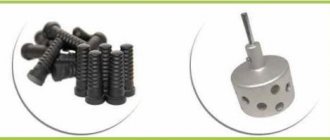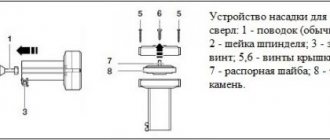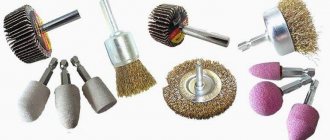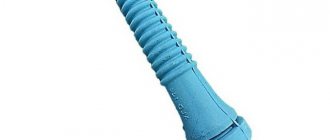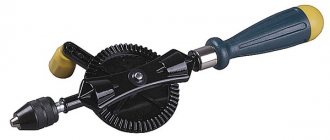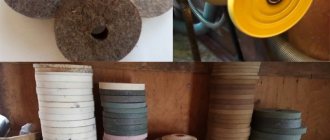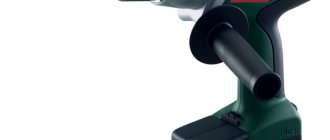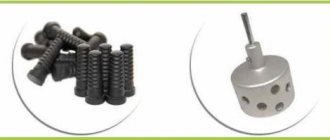Modern power tools are easy to use, but few people know all of their functions.
For example, a suitable sanding drill attachment can be used to make it easy to handle tedious work without spending a lot of effort on it.
Since there are all kinds of drill attachments, we suggest you take a closer look at them.
Advantages and weaknesses
Many manufacturers produce sanding attachments, but not all make sure that the product is reliable.
In competition, preference is given to making products cheaper, so quality suffers.
A third-rate tool will not last long, so you should not focus on the minimum cost. Although the price of high-quality attachments may vary significantly, such a purchase will still be less expensive than purchasing a special tool. Let's pay attention to some criteria.
Advantages
- In some cases, only with the help of this device can you sand a hard-to-reach surface area.
- Convenient for cleaning small parts.
- Devices for an electric drill are cheaper than specialized tools and accessories.
- You can make many sanding attachments yourself.
Flaws
- The device is less convenient to use than a specialized tool.
- You won't be able to work with some attachments without some skill.
- Poor performance.
- Sometimes you can’t do without a drill with adjustable chuck rotation speed.
Since the benefits are more significant, the attachments are popular and used by many people.
Where can it be used
Depending on the type of sanding attachment you purchase, you can use it to:
- clean metal from rust;
- remove paint from iron;
- polish metal;
- polish painted surfaces;
- polish wood parts exposed with varnish;
- polish glass;
- grind the edge of the glass;
- grind small parts;
- remove scale, burrs from metal and correct other defects in places where it is not possible to do this with another tool;
- perform grinding of products in places where grinding cannot be done with another tool.
This is an incomplete list that could be expanded.
Design features
As mentioned above, almost every type of milling device has distinctive design features. This especially applies to end varieties. But at the same time, there are products with different tooth shapes.
An important element is the teeth.
the pointed teeth of the cutter have a serious drawback
The backed teeth behave completely differently. They are not afraid of frequent sharpening or intensive work with metal. Therefore, they are more reliable and durable. For drills, and for machines in general, this is an ideal option.
Is the milling cutter a single unit?
In addition to differences in shape, cutters are also divided into one-piece and prefabricated models. The first option is made from one piece. To avoid unnecessary waste of expensive material, many small cutters are made from one block. Therefore, this approach significantly reduces the cost of the product.
Prefabricated models are also available. As the name suggests, the cutter is manufactured individually and then all the components are connected to each other. Most often, the body is made of cheap types of steel, while the teeth are made of hard materials (most often alloys). Of course, the cost of the design increases, but thanks to this device, you can easily replace one component with another.
What types of devices are there?
Unlike attachments for grinders, any device for a drill is equipped with an axis fixed in the chuck.
Plate
Most drill grinding attachments are made of plastic. They are primarily intended for use in an angle grinder, but thanks to the adapter they can be mounted in a tool chuck.
This type of fastening is rigid and therefore not applicable in all cases. For example, even with a slight displacement of the nozzle, its edge can bite into the surface being sanded, leaving deep grooves.
For this reason, it is more convenient to use a hard plastic attachment by holding the drill still, as in the following illustration.
A rubber attachment is more convenient when working with a drill - thanks to its flexibility, accidental damage to the surface being worked is eliminated when the drill is tilted or pressed excessively.
Another type of similar grinding tool is made with a movable pin mount, but due to the high cost of the latter, it is not in great demand.
Cup
Structurally, the cup attachments are practically no different from each other, but the brush itself can consist of metal (steel, brass) wire or polymer abrasive bristles.
Each brush has a certain hardness and is used strictly for its intended purpose, established by the manufacturer - you can grind metal (removing traces of corrosion), wood and other materials.
Working with such a tool is fraught with some difficulties - by choosing the wrong angle, you can ruin the soft material being processed, and the drill itself constantly strives to move to the side when pressing the device over its entire area.
Disk
These attachments are similar to cup attachments, but the direction of the bristles is different - to the sides. Most often they are used when it is necessary to process material in hard-to-reach places.
Drums
This device resembles a drum in appearance, and thanks to this similarity it received the name of the same name. Such a drum attachment is a cylinder with sandpaper attached to the outer wall.
This device is secured by tension with a special bolt or fixed by pumping with compressed air. When using an open belt, tension is created by a rotating screw that pulls on the sandpaper.
With the help of drum attachments, it is not difficult to sand parts made of wood and metal. A grinding attachment with fine particles of abrasive material can be used when processing the edge of glass. Very convenient for grinding round and oval holes.
Fan
This attachment is made in the form of a disk with fixed fragments of abrasive material. This feature of the tool significantly expanded the range of sizes of processed parts, grinding the cavities of small and large holes. Thanks to the flexibility of the blades, parts of various shapes can be sanded.
End
Such nozzles have different shapes, and the working part can be made of various materials.
Designed for starting or finishing processing of holes and the inside of shaped workpieces. Jewelers and dentists use similar devices, only in miniature size.
Soft
When polishing a workpiece, round foam rubber, felt or leather attachments fixed on an axis can be used. Such a device wears out quickly; it can be used to polish metal or a coating exposed by varnish/paint to a mirror shine. The device is matched directly to the material being polished.
Read also: Deep 500 lathe technical specifications
Wood crowns - ranking of the best
Ready-made sets of ring drills are reliable and safe. The TOP of the best models of adjustable crowns for wood is as follows.
- The drilling set “Bison 29554-H15_z01”
consists of 15 items, the diameter of the bits varies from 1.9 to 12.7 mm. The centering drill is made of durable HSS steel. The set copes with different types of materials - wood, plastic, chipboard, plasterboard. - “MATRIX 70472”
– bimetallic wood crowns made of carbon steel, in a convenient case for storage and carrying. The set is completed with two holders and a centering drill, the maximum diameter of the bit is 2.8 mm. - “Bosch 2609255634”
- the model is compatible with any type of drill. The diameter of the holes that can be drilled using drills is from 46 to 81 mm. The wood bit provides a drilling depth of up to 3.1 cm, the weight of the set is only 500 g.
Homemade devices
It is not only the desire to save money that drives a person when creating a homemade nozzle - sometimes the necessary device simply cannot be purchased, and then one has to design and invent it. In this section we will show several options for attachments that can be made at home using improvised materials.
Based on Automotive Valve
To make such an attachment you will need one or more flat bottom car valves. It is better to make a larger nozzle from a truck exhaust valve.
The surface must be degreased and a head of the desired shape must be glued, which can be made of wood, dense foam, rubber and other suitable material, and then glued to the valve with epoxy or polyurethane glue.
Now you need to cut out circles from sandpaper. The nozzle turned out to be 5.5 cm wide - cut out the same circle for it.
Not reaching the center, cuts are made on the sides and adjusted so that each petal overlaps the other (as this device rotates).
Hot melt adhesive was used to glue the sandpaper.
After gluing the sandpaper, the edges of the petals were secured with staples.
The nozzle did an excellent job, but it quickly clogged because the sandpaper used was fine-grained.
Hence the conclusion - you need to make several attachments so that you can perform different types of work.
Drill requirements
Milling means processing an object with a cutter; it is located in the engine housing. The master controls the work processes, he regulates the speed of rotation and the depth of penetration into the workpiece. When working on a milling machine, the part being processed moves.
Electric drill with attachments
When using a drill, the device itself is moved, which must be suitable for milling. These operations require great precision, where the main force falls on the drive.
If the workshop plans to carry out small milling work that does not promise serious loads, a regular electrical appliance will do.
The operating principle of such a tool is based on the speed of the shaft, and it is ensured by the engine. From the functional part the load is transferred to the installed actuator - drill or cutter.
Equipment elements
These are equipment elements; they have to perform specific actions with the material:
- in-depth sampling;
- contour notch;
- cutting grooves or ledges.
The cutting element is installed taking into account:
- power unit power;
- management methods;
- drill brands;
- center of gravity.
Only at high speed can an object be processed cleanly. On a special machine they reach an average of 25,000 rpm. For the highest-speed drill, this figure is 4500 units. No model can achieve the same quality as a production router, but it is not always needed in a home workshop or even on a construction site. For a hand-held electric tool that transmits rotational movements to the equipment, the following conditions are required:
- shaft rotation at a minimum speed of 1500 rpm, it is desirable that the speed be regulated;
- mechanical power with a margin of safety, since milling occurs with large lateral loads;
- installation of a chuck that will ensure reliable grip of the shank.
If you mill with a drill in the wrong position, the resistance forces will be directed incorrectly:
- the load vector will change, which will bring the gearbox out of operation with additional pressure on the material;
- the engine will need frequent shutdowns to avoid overheating;
- the anchor is deformed;
- the cartridge will not withstand the influence of excessive forces.
To cut profile recesses with different recesses, recesses or grooves in workpieces, you need to select not only a drill, but also a cutting part in accordance with the configuration and width.
Simple screw device
To make this attachment you will need a long screw, 2 washers, a nut, and several pieces of sandpaper.
A washer is placed on the screw. After cutting the sandpaper into squares, a hole is made in the middle, and all the pieces are put on the screw. Then comes the turn of the second washer, and this entire set is clamped with a nut.
By inserting the device into a drill, you can grind the cavities of wooden parts with it.
The disadvantage of such a device is that the threads are jammed by the drill chuck, which creates a problem with re-applying sandpaper. The unnecessary part of the thread can be removed or 3 slots can be made on the screw - our homemade device will be clamped with a drill chuck.
The drill attachment will help you make a square hole for a socket in 30 seconds
English engineers presented a device for quickly drilling square and rectangular holes in plasterboard walls for flush-mounted electrical installation products (sockets, switches, dimmers, etc.).
The Quadsaw device is simply inserted into the drill, after which you can start working. Thanks to four particularly strong blades and a built-in level, an even square (7.5 × 7.5 cm) hole of the required depth with absolutely smooth edges is obtained in the wall.
If necessary, the blades can be rearranged and a rectangular hole can be cut for a double electrical box.
For professional craftsmen, the cutting process takes from 6 to 10 seconds, for less experienced ones it will take no more than 30 seconds.
2
Polishing device
As in the previous case, we will need a screw, washers and a nut, only felt will be used instead of sandpaper. Having marked a piece of felt, cut out circles of the same radius from it.
Holes are made in the center of the workpieces, they are threaded onto a screw, and then clamped with a nut. The finished device is inserted into the drill chuck.
Felt alone will not polish the part, so after turning on the drill, rub the attachment with Goya paste. After this you can start working.
For the purity of the experiment, an old and rusty wrench was used. As you can see in the photo, after a short polishing, the treated area was effectively cleaned in a short period of time.
This polishing attachment can work with both flat and shaped parts, but it will not cope even with small recesses.
Leather circle
As in the device described above, leather can be attached instead of felt, resulting in a device for straightening wood cutters.
We use a file
A round file can be used as an attachment by removing the handle from it and holding the shank in the chuck. It is better to secure a file of small diameter to the base.
Using this device, it is convenient to grind holes and semicircular depressions.
Epilogue Regardless of whether you use a purchased drill attachment or make one yourself, it can be an invaluable assistant in many jobs.
The main purpose of a drill when working with wood is to drill holes. However, this tool is much more functional than many people think. To expand its functionality, special wood attachments are used, which, in fact, is the subject of this article.
Electric drill with attachment
Next, we will look at what drill attachments exist for woodworking and for what purposes they are used.
DIY wood crown
Any craftsman may encounter a situation where a drill of a suitable diameter is not at hand. For work that does not require high precision and accuracy, you can make a wood crown for a rosette yourself in a couple of hours. The list of materials is minimal: a metal pipe of the required diameter, a “fist” from a door hinge, a drill, a screw, a rectangular steel plate.
- In the “fist”, using a vice, you need to drill a hole corresponding to the diameter of the drill.
- On the side of the “fist”, at a distance of at least 1 cm from the edge, another threaded hole should be made, intended for a fixing screw.
- Using a grinder, you need to make cuts along the edge of the pipe that imitate teeth.
- Weld a plate on the back of the pipe, in the center of which make a hole for the drill.
- To assemble the structure, a drill is inserted into the “fist” and secured with a screw. The lower part of the drill is placed in the crown, and the upper part is placed in the tool chuck (drill or screwdriver).
Types of nozzles
Not everyone knows that with the help of attachments, in addition to drilling holes with a drill, you can perform many other operations, such as:
However, it should be said right away that attachments are not a complete replacement for special equipment. The quality of operations performed with their help is inferior to individual instruments. However, in some cases they can significantly simplify wood processing with your own hands.
Below we will take a closer look at all types of attachments for performing the above work.
Drill Drum Attachment for Sanding Wood
Sanding and polishing
There are many types of attachments for grinding and polishing wooden surfaces, the main ones are listed below:
| Type of transaction | Types of nozzles |
| Grinding | Nozzles of this type are a rod with a grinding material attached to it, which can be used as: |
- Sandpaper;
- Special brushes;
- Rigid fabric such as felt.
According to the type of design and shape, grinding heads are of the following types:
- Disc discs - made by analogy with discs intended for conventional grinding machines, the only thing is that instead of threads they have a pin for fixing in the chuck.
- Cup - they are a cup with a brush. They are usually used for removing old paint from wood and other rough treatments.
- Drum type - they are a cylinder with sandpaper attached to the walls. Such heads can be used to process the surface inside the holes, as well as the end of the boards.
- Petal – a large number of sandpaper petals are attached to the rod of this tool. With the help of such attachments, radius grinding of wood with a drill can be performed, as well as processing of parts with complex surfaces.
Read also: Reverse from 380 to 220V
Based on the degree of softness, polishing tips are divided into the following types:
In addition, they can vary in shape and size, which allows you to choose the most optimal tip for polishing a particular type of surface. For example, conical and thin cylindrical nozzles can be used to polish holes.
Felt tips for polishing
The choice of nozzle in this case depends on the operation being performed. For example, if you need to sand a surface in a hard-to-reach place, an excellent option is a sanding attachment on a drill for petal-type wood. If you need to clean the surface from paint or renew it, you should give preference to cup attachments.
Making large diameter holes
To make large diameter holes, several types of nozzles are used:
- Feather drills - thanks to the flat cutting part and special sharpening, they allow you to make holes in wood, chipboard, plywood and OSB with a diameter of up to 60 mm. It should be noted that feather drills are available not only for wood, but also for metal.
Attachment with a set of wood crowns
- Wood drill bit – allows you to drill holes in wood with a diameter of up to 100 mm.
- Forstner drill – has a centering tip. Using such a drill, you can make blind holes, for example, for installing hinges in furniture making.
In the photo - Forstner drills
Advice! When making holes in chipboard and other similar materials, do not press the drill too hard, as this can lead to chips and cracks.
It must be said that there are special devices on sale that allow you to change the drilling angle. Their purpose is to provide ease of drilling in hard-to-reach places.
Cylindrical wood cutter for drill
Milling
With the help of special tips, the drill can even be used for milling wooden parts.
There are different types of cutters (cutters):
- Cylindrical;
- Face;
- End;
- Disk;
- Shaped, etc.
The choice of cutter depends on the type of operation being performed. For example, if it is necessary to make grooves in a part, use disc cutters for wood drilling. To make complex cuts, it is better to use shaped cutters.
It should also be noted that cutters differ in the shape of the teeth, which are:
- Pointed;
- Backed.
The good thing about backed teeth is that, if necessary, they can be resharpened, while pointed teeth cannot be restored.
Wood cutting attachment
cutting
The attachment on a drill for cutting wood is a rather complex mechanism that works on the principle of a jigsaw. It can be used to cut wood up to 20 mm thick, as well as plywood and chipboard.
In addition, the attachment can be used to cut plastic and even steel. Thus, this device will be useful to every home craftsman, unless, of course, there are special tools for cutting a particular material.
However, it should be noted that the price of such a nozzle is quite high, which is explained by the complexity of its mechanism.
Advice! Before making an internal cut with a jigsaw attachment, you need to drill a hole with a diameter equal to the width of the file.
Nozzles for screwing in self-tapping screws
Screwing in self-tapping screws
The nozzle for screwing in self-tapping screws is the simplest type of tip. However, it should be noted that it can only be used with those types of drills that have a speed reduction option.
These products are usually sold in sets containing heads of several diameters. This allows you to work with self-tapping screws and screws of different sizes.
Here, perhaps, are all the most common types of nozzles. It must be said that there are also less popular tips, for example, flexible drills on cables, which allow you to make holes in hard-to-reach places, as well as angle attachments, which allow you to turn a drill into an angle grinder. True, they can be found on sale much less often.
Drill with angle attachment
Where are sanding attachments used?
Figure 2. Areas of operation of the drill
Grinding attachments for drills significantly increase the range of application of the device. With such parts, the device can replace a full-fledged grinding machine. This allows you to stop keeping a large selection of different power tools at home and limit yourself to a few components.
Attachments are used for a wide range of work on metal, wood and even concrete. They help clean the surface from rust, old varnish or paint. Suitable for sanding coatings after priming. If necessary, surface polishing materials can be used.
Work performed using grinding devices includes:
- cleaning the surface for subsequent processing or painting;
- getting rid of rust;
- polishing surfaces to a shine;
- boring holes in metal, giving the required shape;
- ridding the part of burrs, excess protrusions and growths.
These are just the main tasks that can be solved using such a tool. In addition to them, there may be other types of work that require a similar type of surface treatment.
To install attachments in a drill and screwdriver, attachments are used that are securely attached to the chuck. But it is worth noting that the screwdriver will not allow you to work comfortably with attachments, as it operates at low speeds.
For the convenience of carrying out some types of work, the drill is fixed in a stationary tripod. In this case, the tool is used as a full-fledged grinding machine.
Basic rules for working with a drill and attachments
When using an electric drill, like any other power tools, the operating instructions and safety regulations must be strictly followed.
Below are the main ones:
- Before processing, the workpiece must be securely secured.
- The nozzle must be securely fixed in the cartridge. If there is play, it is prohibited to work with it.
- When working with a drill, it must be held with both hands, especially for powerful models.
- The pressure should not be excessive.
- It is forbidden to turn on the reverse mode until the drill has stopped completely.
- When working, you must use personal protective equipment - gloves and goggles.
- After completing the work, do not touch the drill or other tip for some time, as you may get burned.
Note! You should not try to make a nozzle or adapter yourself. The fact is that electric drills operate at high speeds, as a result of which a poor-quality or unbalanced attachment can cause injury.
Observing these simple injuries will make the work safe, which is the most important thing when performing any construction operations.
Read also: Smoke generator operating principle in detail
Features of the material
Metal tiles are profiled sheets of galvanized steel, onto which a polymer coating is applied that protects the material from rust and mechanical damage. The polymers used for the production of roofing (pural, plastisol, polyester) have a fairly low melting point, so it is not recommended to use an abrasive tool for cutting metal tiles. The use of such devices causes the following consequences:
- When the grinding disc operates at high speed, the polymer coating along the edges of the cut melts, resulting in the formation of “bald spots” of unprotected metal on the surface of the metal tile.
- When cutting metal tiles with an abrasive tool at high speeds, the edges of the cut are heated to a significant temperature, due to which the properties of the steel change for the worse and the zinc layer melts.
- After 1-2 years of operation, places where the polymer and zinc layers are damaged due to the use of an abrasive cutting tool become centers of corrosion, irreversibly destroying the structure of the material.
Structure of a metal tile sheet
Conclusion
Thanks to the large number of woodworking attachments available, the drill is one of the most functional tools. It especially makes sense to use all kinds of tips in cases where the need to process wooden parts arises only from time to time. Of course, for frequent and especially professional work, it is necessary to purchase separate tools.
You can get some additional information on the topic discussed above from the video in this article.
The use of special devices clamped in the chuck of this power tool makes it truly multifunctional. For example, you can even cut sheet iron with it. Considering the variety of drill attachments for woodworking, it is unrealistic to go into detail about each of them in one article. We will deal only with attachments that allow using a drill to perform high-quality and quick surface mechanical processing of wood.
What is it? Preliminary cleaning of the surface (rough), removal of burrs, grinding and bringing to a mirror shine (polishing). All other technological operations with wood - milling, drilling, screwing in fasteners, cutting - do not belong to the concept of “processing”. This is what the author proceeds from. The difference in the listed types of work in relation to attachments is in the rotation speed of the drill chuck and the type of device. Which one to choose is decided mainly based on the required degree of processing of the tree and its species (that is, the density of the structure).
How to use wood crowns?
A core drill has the shape of a cylinder, one edge of which is made in the form of sharp teeth, and the other has a tip. A wood bit for a drill is essentially an attachment that can complement any hand tool. The cutter must be installed in a special glass and secured with a nut. The drill, which is located in the very center of the crown, is designed to determine the exact location of the center of the hole and obtain a perfect cut. If you follow the operating rules, any tools, including core drills, will last a long time.
Classification of attachments for wood processing
Prices are indicative, in relation to the Moscow region, in Russian rubles
By type of abrasive
- Hard fabric.
- Foam rubber.
- Plastic.
- Sandpaper of different grain sizes.
- Rubber.
- Cord brush.
According to the degree of wood processing
- Abrasive (rough).
- Grinding.
- Polishing pads (soft and super-soft pads).
By execution
Depending on the configuration, the attachments are used not only for surface treatment of wood. They can be used to grind (polish) holes (as a replacement for a sander). This is easy to do with cylindrical (thin) or conical devices.
Plate attachments
Available in several modifications. The difference is in the form of abrasive material. If wood sanding is required, then it is rubber (the more preferable option) or plastic. For polishing, it is advisable to purchase attachments with fine-grained sandpaper fixed on the working part. They can achieve higher quality (fine) wood processing.
Recommendation: Effective processing of wood with a plate-type drill attachment is difficult because it is difficult to hold the drill in a strictly vertical position. To achieve a good result, it is advisable to fix the tool and move the workpiece relative to the working part. The machine for attaching the drill is easy to assemble yourself.
There are nozzles on sale that provide for adjusting the angle of the abrasive mounting pin. But they are quite expensive, and not every store can buy them. Therefore, a machine with the ability to change the position of the drill is a more acceptable solution.
Drum attachments
Mainly used for processing the end parts of wooden workpieces and holes. They have a cylindrical shape and differ in the way the sanding tape is attached - using a bolt or special inflatable blocks. Some types of attachments of this type are also used in everyday life for plucking (at low speed) birds when it comes to a large amount of work.
Cup attachments
The assortment is significant. The differences are in size and abrasive material. These can be either metal “hairs” (hard wire) or thick fabric, leather, felt and even foam rubber. The choice of device is determined by the desired degree of wood processing. If you want to achieve a sharper highlighting of the texture of the material, then the wood pulp is sampled using just such attachments.
A variety of devices in this group are disk attachments. The difference is clear from the figure (the villi are located diametrically).
This type of attachment can also include fan devices. They are also called petal.
The main purpose is to polish wood at the final stage of processing.
Tool selection
The high efficiency of instruments of this type is determined by a number of specific parameters. Among the performance indicators, the most important are:
- the nature of the operation being performed;
- characteristics of the processed material;
- geometric dimensions of the part;
- head shape;
- type of cutting notches;
- properties of power tools.
When choosing a device, it is also recommended to take into account the power and number of revolutions of the equipment being equipped. The technical characteristics of the product must correspond to the metric indicators of the tool.
Metal emery with a fine, universal, ultra-fine notch and for working with soft metals can have a head of a specific shape. The effectiveness of the device depends on the shape and location of the cutting part; the tool may have:
- rare teeth for processing an alloy of aluminum and copper;
- standard size teeth for edge processing and deburring;
- multi-directional teeth for working with hard metals.
For processing products made of non-ferrous metals, experts recommend using corundum emery with reinforced sharpening. A diamond or abrasive cutter, as well as a tool with the main part of the double sharpening, will help to remove burrs. When grinding the surfaces of products, a conical burr with ultra-fine cutting is used.
What to consider when choosing drill attachments
- Using attachments, for example, the same grinding attachments, you can process not only wood, but also other materials - metal, glass, ceramics, and so on. You just need to select the appropriate modification of the device.
- According to reviews from practitioners, identical attachments from different manufacturers can differ greatly in effectiveness and duration of use. Therefore, you should not save on purchasing products from a little-known brand. It is not a fact that such a device will not become unusable after short-term use.
- Even an expensive attachment will cost much less than a special power tool. For example, a grinding machine, for which you will also have to additionally purchase the appropriate accessories (blade, wheel, etc.) depending on the type of product.
- When choosing any attachment, you should focus on the following features of your electric drill: power, chuck size, ability to regulate speed. Otherwise, the ease of use of the device and the high quality of wood processing are not guaranteed.
The article discusses the main types of drill attachments. Each group is available in several modifications; In addition, manufacturers regularly supply some new products to the market. Therefore, the choice of size, configuration, and abrasive must be made for a specific technological operation, especially since it exists and is quite large. This can achieve the highest quality results in wood processing. Considering that it is impossible to foresee everything, especially without extensive practical experience in working with nozzles, it is better to purchase them in specialized stores. Based on the characteristics of the buyer’s drill, the seller will help make the best choice.
| Polishing | Polishing attachments resemble the heads described above, the only difference is that the filler is made of soft materials, which means they provide a finer surface finish. Most often, these products take the form of a disk made of soft material on which foam rubber, felt, felt or other soft filler is attached. |
How to choose
Figure 9. Manufacturer selection
The devices come under many brands, many of which are also instrument manufacturers. Among the variety, it can be difficult to choose just one. It is recommended to pay attention to the products of well-known brands that have long proven themselves in a particular field. The most common products are from Makita, Bosch, Verto, Praktika, and Zubr. If you do not buy products from nameless manufacturers, you can significantly reduce the likelihood of buying a product that is not the best. Do not forget that purchasing a device in itself is a savings compared to selecting professional grinding equipment.
But before choosing a manufacturer, it is better to understand the basic requirements for the tool. Determine for what specific work the component is being purchased. It is worth determining the characteristics of the drill. After all, if you choose a bad attachment for a specific tool model, then you won’t have to think about quality work.
Device for converting a drill into a circular saw and grinder
A special adapter can turn the drill not only into a real circular saw, but also into a grinder.
The device consists of a clamp that securely fixes the drill, a mount for a gear wheel or grinding wheel, and a platform measuring 75 × 85 × 11 mm, which is screwed to the surface of the work table.
All adapter parts are made of metal and are particularly durable.
Having such a device in his arsenal, the master, in addition to the drill, receives two more useful tools: a circular saw and a grinder.
Price - about 800 rubles.
9
Dry and wet sanding
How to properly sand wood with a sander or other tool? First, it is important to choose the type of procedure. It can be dry or wet. The first type increases the effectiveness of the abrasive and ensures its accurate removal. The downside of this technology is that the skin easily becomes clogged with dirt.
When carrying out wet sanding, you need to apply the liquid to the grainy surface of the sandpaper. Mineral oil or soap solution can be used for this. White spirit will also work.
Note! During the wet procedure, the abrasive becomes much less clogged, which helps to increase its service life. This creates an unpleasant mass of foam and shavings.
